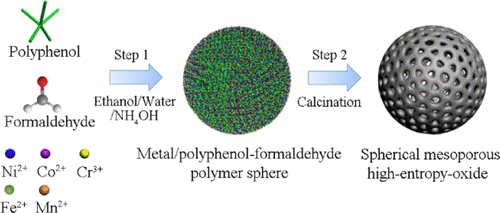当前位置:
X-MOL 学术
›
ACS Appl. Mater. Interfaces
›
论文详情
Our official English website, www.x-mol.net, welcomes your
feedback! (Note: you will need to create a separate account there.)
Sol-Gel Synthesis of Spherical Mesoporous High-Entropy-Oxides.
ACS Applied Materials & Interfaces ( IF 8.3 ) Pub Date : 2020-09-11 , DOI: 10.1021/acsami.0c11899 Gen Wang 1, 2 , Jing Qin 1 , Youyou Feng 1 , Bingxi Feng 1 , Shengjiong Yang 2 , Zheng Wang 3 , Yongxi Zhao 1 , Jing Wei 1
ACS Applied Materials & Interfaces ( IF 8.3 ) Pub Date : 2020-09-11 , DOI: 10.1021/acsami.0c11899 Gen Wang 1, 2 , Jing Qin 1 , Youyou Feng 1 , Bingxi Feng 1 , Shengjiong Yang 2 , Zheng Wang 3 , Yongxi Zhao 1 , Jing Wei 1
Affiliation

|
High-entropy oxides (HEOs) have attracted increasing interest owing to their unique structures and fascinating physicochemical properties. Spherical mesoporous HEOs further inherit the advantages of spherical mesoporous materials including high surface area and tunable pore size. However, it is still a huge challenge to construct HEOs with uniform spheres and a mesoporous framework. Herein, a wet-chemistry sol–gel strategy is demonstrated for the synthesis of spherical mesoporous HEOs (e.g., Ni–Co–Cr–Fe–Mn oxide) with high specific surface area (42–143 m2/g), large pore size (5.5–8.3 nm), unique spherical morphology (∼55 nm), and spinel structure without any impure crystal phase using polyphenol as a polymerizable ligand. The metal/polyphenol–formaldehyde resin colloidal spheres are first synthesized via a sol–gel process. Because of their abundant catechol groups and strong chelating ability with different metal species, polyphenols can not only accommodate five different metal ions in their networks but also be well polymerized by formaldehyde to form colloidal spheres. After calcination, the metal species aggregate together to form HEOs, while the organic resin is fully decomposed to produce mesopores. Because of the open framework with accessible mesopores, they could be used as a peroxymonosulfate catalyst for degradation of organic pollutants and a nanoplatform for efficient detection of DNA. This work demonstrates a straightforward sol–gel strategy for design and synthesis of spherical mesoporous high-entropy materials, which would promote the exploration of new properties of high-entropy materials and extend their application.
中文翻译:

球形介孔高熵氧化物的溶胶凝胶合成。
高熵氧化物(HEOs)由于其独特的结构和引人入胜的理化性质而引起了人们的兴趣。球形介孔HEO进一步继承了球形介孔材料的优点,包括高表面积和可调孔径。但是,构建具有均匀球体和中孔框架的HEO仍然是巨大的挑战。在这里,湿化学溶胶-凝胶策略被证明可以合成具有高比表面积(42-143 m 2)的球形介孔HEO(例如,Ni-Co-Cr-Fe-Mn氧化物)/ g),大孔径(5.5-8.3 nm),独特的球形形态(〜55 nm)和尖晶石结构,没有任何不纯的晶相,使用多酚作为可聚合配体。金属/多酚-甲醛树脂胶体球首先通过溶胶-凝胶法合成。由于多酚具有丰富的邻苯二酚基团以及与不同金属种类的强螯合能力,因此多酚不仅可以在其网络中容纳五种不同的金属离子,而且可以被甲醛充分聚合形成胶体球。煅烧后,金属物质聚集在一起形成HEO,而有机树脂被完全分解以产生中孔。由于具有可接近的中孔的开放框架,它们可用作过氧化单硫酸盐催化剂,用于降解有机污染物,以及用作有效检测DNA的纳米平台。
更新日期:2020-10-07
中文翻译:

球形介孔高熵氧化物的溶胶凝胶合成。
高熵氧化物(HEOs)由于其独特的结构和引人入胜的理化性质而引起了人们的兴趣。球形介孔HEO进一步继承了球形介孔材料的优点,包括高表面积和可调孔径。但是,构建具有均匀球体和中孔框架的HEO仍然是巨大的挑战。在这里,湿化学溶胶-凝胶策略被证明可以合成具有高比表面积(42-143 m 2)的球形介孔HEO(例如,Ni-Co-Cr-Fe-Mn氧化物)/ g),大孔径(5.5-8.3 nm),独特的球形形态(〜55 nm)和尖晶石结构,没有任何不纯的晶相,使用多酚作为可聚合配体。金属/多酚-甲醛树脂胶体球首先通过溶胶-凝胶法合成。由于多酚具有丰富的邻苯二酚基团以及与不同金属种类的强螯合能力,因此多酚不仅可以在其网络中容纳五种不同的金属离子,而且可以被甲醛充分聚合形成胶体球。煅烧后,金属物质聚集在一起形成HEO,而有机树脂被完全分解以产生中孔。由于具有可接近的中孔的开放框架,它们可用作过氧化单硫酸盐催化剂,用于降解有机污染物,以及用作有效检测DNA的纳米平台。











































 京公网安备 11010802027423号
京公网安备 11010802027423号